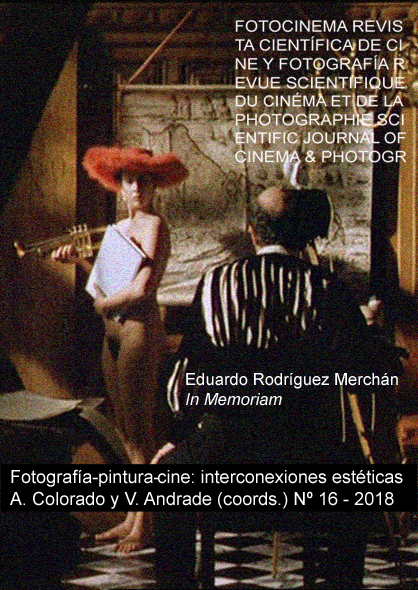Twin Peaks 03: A 18 hours lenght canvas
DOI:
https://doi.org/10.24310/Fotocinema.2018.v0i16.4109Keywords:
David Lynch, Digital, Narrative, Twin Peaks, Inland Empire, Painting.Abstract
David Lynch’s latest creation, released simultaneously Worldwide this year 2017 it’s been a surprising sequel of the TV Series he started in 1990, but with a brand new style and narrative that put it closer to videoart and which has references from the most important painting artists of the 20th Century. The transition from chemical cinema to digital cinema through short films made for his website changed the way David Lynch expresses himself and ended up with the construction of the long feature film Inland Empire in 2006. Since then, all his creative production has changed, setting him aside from big Hollywood industry, but three years ago he was asked to continue Twin Peaks, cancelled in 1991. After analysing the content of Lynch’s artwork we’ll see that artits like Francis Bacon or Edward Hopper are a constant influence in Lynch filmography, but to enumerate influences is just a small part of the purpose because it’s not a question of the content but of the creative process what makes the series a pioneer in a new narrative product for massive consumtion through televisión. The change of cinematographic techniques made this artwork something beyond television narrative.
Downloads
Metrics
Publication Facts
Reviewer profiles N/A
Author statements
Indexed in
-
—
- Academic society
- N/A
- Publisher
- Universidad de Málaga
References
Aumont, J. & Bergala, A. & Marie, M. y Vernet, M. (1996). Estética del cine. Barcelona: Paidós.
Benjamin, W. (1966). El autor como productor. México DF: Ediciones Ítaca.
Borau, J. L. (2007). El Papa y sus Antípodas. En El Museo del Prado y el Arte Contemporáneo. (pp. 265-288). Barcelona: Galaxia Gutemberg.
Borau, J. L. (2003). La Pintura en el Cine. El cine en la Pintura. Madrid: Ocho y Medio Libros de Cine.
Cerrato, R. (2009). Cine y Pintura. Madrid: Ediciones JC.
Freud, S. (1966). La interpretación de los sueños 1. Madrid: Alianza Editorial.
Harrison, M. (2005). In Camera. Francis Bacon: Photography, film and the practice of painting. Reino Unido: Thames & Hudson.
Lim, D. (2015) David Lynch. The man from another place. EE.UU.: Icons.
Lynch, D. (2006). Catching the big fish. Londres: Penguin.
Lynch, D. (2002). Lección de cine. En Tirard, Laurent (Coord.), Lecciones de cine. (pp. 137-145). Barcelona: Paidós.
Ortiz, Á. & Piqueras, M. J. (1995). La Pintura en el Cine. Barcelona: Paidós.
Powell, J.(2014). David Lynch, Francis Bacon, Gilles Deleuze: The Cinematic Diagram and the Hall of Time en Discourse. Journal for theoretical Studies in Media and Culture: Vol 36. (pp 309-339). EE.UU. Wayne State University Press.
Rodley, C. & Lynch, D. (1997). David Lynch por David Lynch. Barcelona: Alba Editorial.
Viola, B. (2007). Quietud Conmovedora en El Museo del Prado y el Arte Contemporáneo. (pp. 265-321). Barcelona: Galaxia Gutemberg.
Von Trier, L. (2002). Lección de cine. En Tirard, Laurent (Coord.), Lecciones de cine. (pp. 193-201). Barcelona: Paidós.
Peliculas y recopilaciones audiovisuales en dvd video on demand:
Barnes, Rick. & Neergaard-Holm, Olivia y Nguyen, Jon. (2017) David Lynch The Art Life .
Blackandwhite. (2006) Lynch (one).
Boyle, Danny. (2002). 28 Days Later.
Keeler, Toby (1997) Pretty as a picture: The art of David Lynch.
Kooistra, Menno (2017). The art of David Lynch.
Lynch, David. (2007). Dynamic one: The Best of davidlynch.com. Absurda. PAL.
Lynch, David. (2007). Inland Empire. (Ed. Británica dvd) Optimum releasing. PAL.
Lynch David. (2007) Inland Empire. (Ed. Estadounidense dvd) Absurda. Rhino. Studiocanal. NTSC.
Lynch, David. (1997). Lost Highway.
Lynch, David. (2001). Mulholland Dr.
Lynch, David. (1966). Six Figures Getting Sick (Six Times).
Lynch, David. (1990, 1991) Twin Teaks Temporadas 01, 02 y extras. Paramount Spain.
Lynch, David. (2017) Twin Peaks 03. Distribuida por Movistar +.
Von Trier, Lars. Idioterne (1998).
Downloads
Published
How to Cite
Issue
Section
License
All contents published in Fotocinema Revista científica de cine y fotografía are protected under the Creative Commons Attribution-NonCommercial-ShareAlike 4.0 International (CC BY-NC-SA 4.0) license. All about this license is available in the following link: <http://creativecommons.org/licenses/by-nc-sa/4.0>
Users can copy, use, redistribute, share and exhibit publicly as long as:
- The original source and authorship of the material are cited (Journal, Publisher and URL of the work).
- It is not used for comercial purposes.
- The existence of the license and its especifications are mentioned.
There are two sets of authors’ rights: moral and property rights. Moral rights are perpetual prerogatives, unrenounceable, not-transferable, unalienable, imprescriptible and inembargable. According to authors’ rights legislation, Fotocinema. Revista científica de cine y fotografía recognizes and respects authors moral rights, as well as the ownership of property rights, which will be transferred to University of Malaga in open access. The property rights are referred to the benefits that are gained by the use or the dissemination of works. Fotocinema. Revista científica de cine y fotografía is published in an open access form and it is exclusively licenced by any means for doing or authorising distribution, dissemination, reproduction, , adaptation, translation or arrangement of works.
Authors are responsable for obtaining the necessary permission to use copyrighted images.














13.png)



